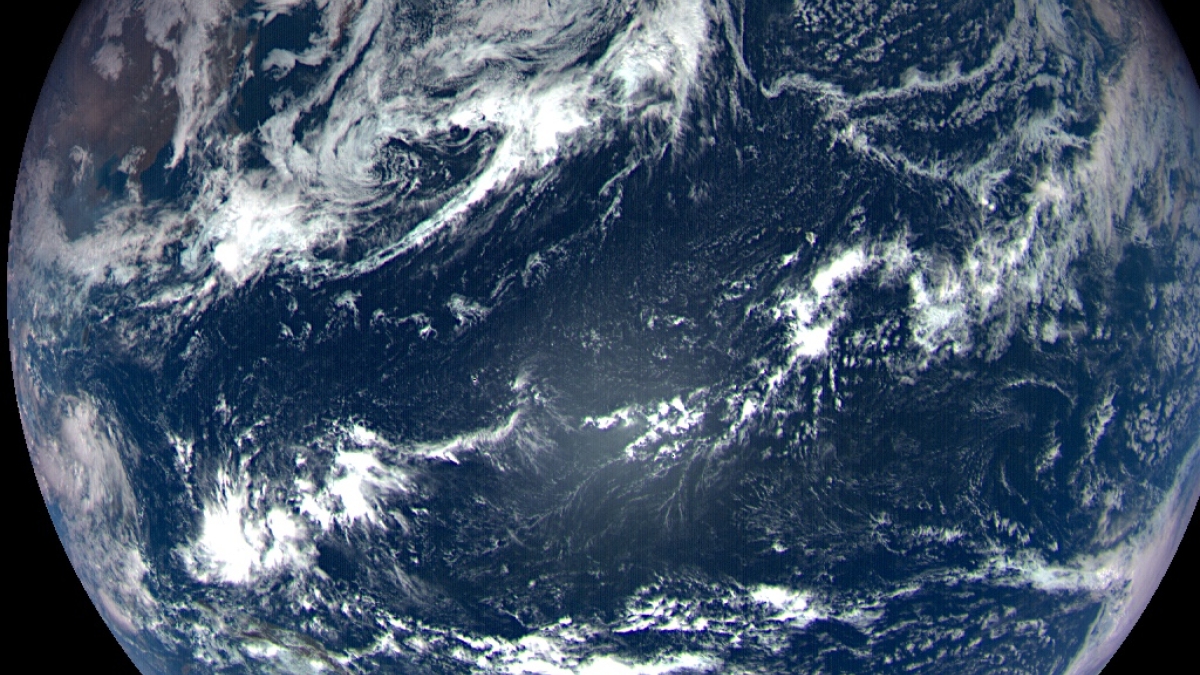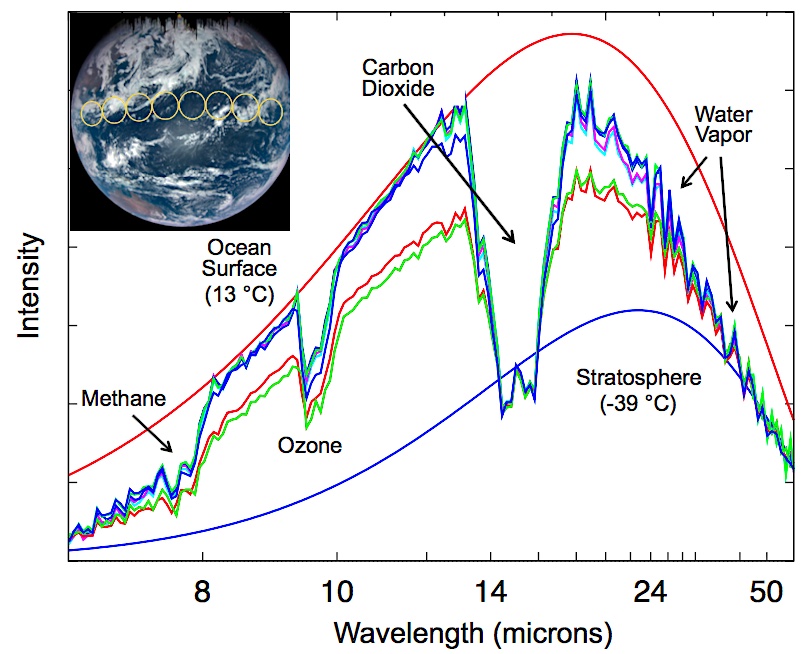ASU spectrometer working perfectly as it flies past Earth on way to asteroid

When NASA's OSIRIS-REx spacecraft flew past Earth on Sept. 22, the OSIRIS-REx Camera Suite (OCAMS) looked back at our planet about two hours after closest approach. The Pacific Ocean and clouds filled most of the view; Australia is visible at lower left. At the same time, the ASU-built OSIRIS-REx Thermal Emission Spectrometer (OTES) took a series of spectral measurements so scientists could calibrate the instrument. OCAMS image from NASA/Goddard Space Flight Center/University of Arizona
Shortly after NASA's OSIRIS-REx spacecraft flew past Earth at a distance of about 11,000 miles on Sept. 22, an ASU-built spectrometer onboard looked at Earth and detected methane, ozone, carbon dioxide and water vapor. Taken together these gases in our atmosphere set Earth apart from other planets.
While hardly a discovery, the findings helped scientists calibrate the ASU-built instrument and show that it is working perfectly after a year in space.
The OSIRIS-REx spacecraft was launched Sept. 8, 2016, from the Kennedy Space Center in Florida. It is now about halfway on the journey to its target, a primitive carbonaceous asteroid named Bennu. The gravity assist the spacecraft received in the Earth flyby changed its trajectory so that it is now on track to arrive at Bennu in August 2018.
OSIRIS-REx stands for Origins, Spectral Interpretation, Resource Identification, Security – Regolith Explorer. The mission's goals are to return a sample of surface rocks, soil and dust from Bennu, map the asteroid's global properties, document the surface at the sample site down to centimeter scales, characterize its type of asteroid for comparison with meteorites, and measure a subtle effect of sunlight that can alter an asteroid's orbit.
The latter two goals are the main scientific tasks for the ASU-built OSIRIS-REX Thermal Emission Spectrometer, or OTES for short. Philip Christensen, Regents’ Professor of geological sciences in Arizona State University’s School of Earth and Space Exploration, designed the instrument, which was constructed on ASU's Tempe campus.
"OTES is the first complex space instrument to be designed and built entirely at ASU," Christensen said. "We're very proud that this instrument is on its way and operating as designed."
With an orbit that comes inside Earth's orbit, Bennu is the most accessible asteroid rich in organic materials from the early solar system. It reflects only 3 percent of the sunlight falling on it, making it about as dark as charcoal.
When OSIRIS-REx arrives at Bennu, OTES will make a global mineral map of the asteroid, which is roughly spherical and about 1,600 feet (500 meters) across. The map will help mission scientists decide the best place to collect surface samples for eventual return to Earth.
Little pushes, little shoves
Given its Earth-crossing orbit, Bennu is also a space rock scientists want to keep an eye on. They estimate that it has a 1-in-2,700 chance of hitting Earth in the year 2170.
Which directly leads to OTES' other major task: measuring the temperature and heat emission over Bennu's surface as it spins through its 4.3-hour-long day. This is to help scientists gauge the strength of the Yarkovsky effect on Bennu.
The Yarkovsky effect is a weak but steady thrust produced by sunlight as it falls on a spinning object. The effect comes from the fact that sunlit ground is warmer in the afternoon than the same ground is in the morning, because sunlight has had longer to heat it.
This means that the afternoon side of a rotating object radiates more heat than the morning side, thus producing an extremely small thrust. The effect is negligible for massive objects like planets, but for small bodies like Bennu the effect could shift its orbit.
Using OTES data, OSIRIS-REx will help scientists assess how fast Bennu's orbit is changing and gather information useful for future generations, which may have to take action to deflect the asteroid.
OSIRIS-REx will remain at Bennu until 2021. Then with the sample of rocks and dust safely packed into a sealed re-entry capsule, the spacecraft will fire its engine and go into an orbit to meet with Earth in 2023.
After releasing the sample return capsule, OSIRIS-REx will fly past Earth and continue in its solar orbit. The capsule with the samples will enter the atmosphere behind a heat shield and land under a parachute in Utah.
Flyby yields first OTES results
Christensen said, "This Earth flyby gave us our first real data. Up to now we have just looked at an onboard test target. It's exciting to collect spectral data on a real solar-system body. OTES has performed exactly as we hoped."
The spectrometer works by examining infrared (heat) wavelengths.
"The infrared is great for identifying minerals," Christensen explained. "Rocks and minerals may look similar to the eye, but they show unique spectra when studied in the infrared, where their 'colors' stand out differently."
Showing almost entirely ocean and clouds, planet Earth (upper left) appears misnamed in this view taken by OSIRIS-REx on Sept. 22, two hours after its closest approach to Earth. The circles, each about 500 miles in diameter, indicate where the OTES spectrometer made its observations. The peaks and valleys in the spectral curves show absorption of solar energy by methane, ozone, carbon dioxide, and water vapor in Earth’s atmosphere. OTES also took the temperature of the ocean surface (red curve, 55 °F) and the stratosphere (blue, -38 °F). Image by NASA/Goddard Space Flight Center/University of Arizona (Earth image) and Arizona State University (OTES spectrum)
As it happened, the flyby trajectory gave OTES a view of Earth dominated by the Pacific Ocean. Almost no land areas came within the instrument's field of view, which saw clouds and seawater.
Even so, the instrument worked as designed. In addition to identifying minerals, the infrared also excels at detecting gases such as methane, ozone, carbon dioxide and water vapor, which are common in our atmosphere.
"We measured them with OTES and got good 'ground truth' results," Christensen explained.
"Earth isn't our prime target, however," Christensen said. "That will come about a year from now. But the Earth flyby was a great test for OTES and the other instruments on the spacecraft.
NASA’s Goddard Space Flight Center provides overall mission management, systems engineering, and the safety and mission assurance for OSIRIS-REx. Dante Lauretta of the University of Arizona, Tucson, is the principal investigator, and the University of Arizona also leads the science team and the mission’s science observation planning and data processing. Lockheed Martin Space Systems in Denver built the spacecraft and is providing flight operations. Goddard and KinetX Aerospace are responsible for navigating the OSIRIS-REx spacecraft. OSIRIS-REx is the third mission in NASA’s New Frontiers Program. NASA’s Marshall Space Flight Center in Huntsville, Alabama, manages the agency’s New Frontiers Program for its Science Mission Directorate in Washington.
More Science and technology

ASU-led space telescope is ready to fly
The Star Planet Activity Research CubeSat, or SPARCS, a small space telescope that will monitor the flares and sunspot activity…

ASU at the heart of the state's revitalized microelectronics industry
A stronger local economy, more reliable technology, and a future where our computers and devices do the impossible: that’s the…

Breakthrough copper alloy achieves unprecedented high-temperature performance
A team of researchers from Arizona State University, the U.S. Army Research Laboratory, Lehigh University and Louisiana State…


